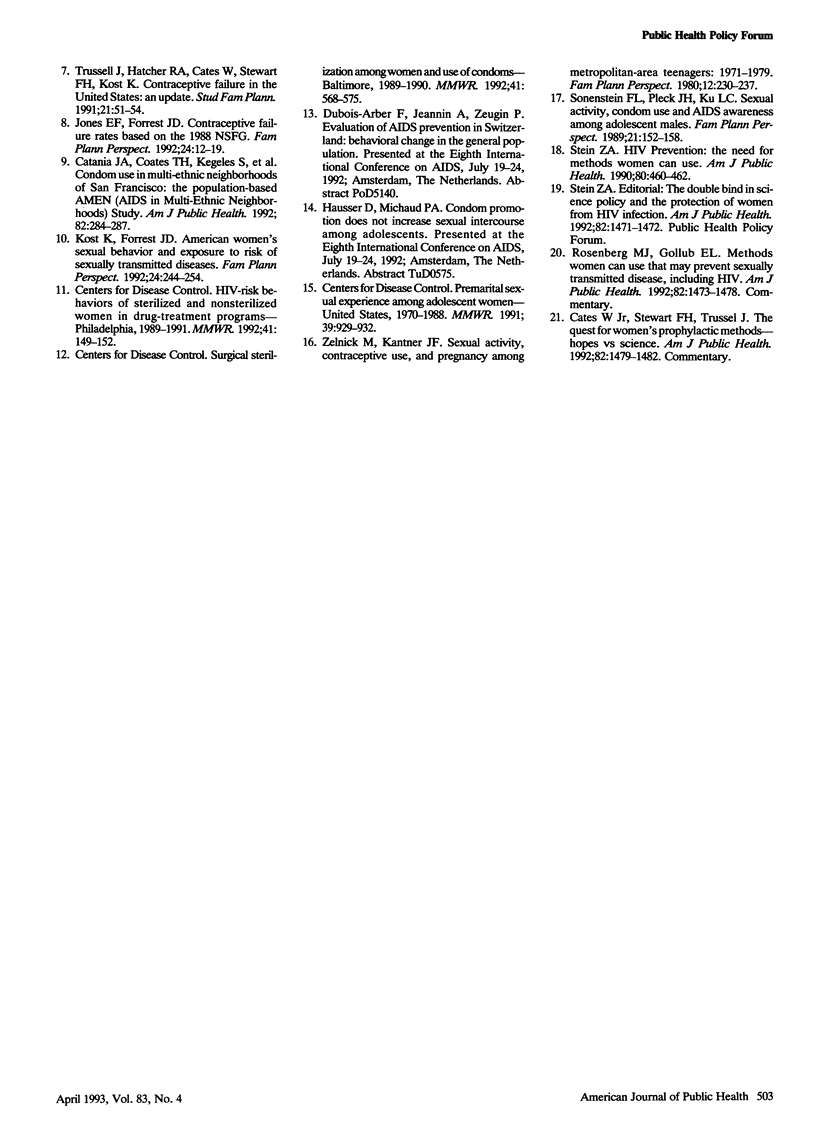Abstract
In the United States and throughout the world, the majority of human immunodeficiency virus (HIV) infections are sexually transmitted. an estimated 12 million other sexually transmitted diseases occur annually in the United States. Avoiding sexual intercourse altogether or restricting sex to partners known to be uninfected will prevent infection; this needs to be promoted as the most effective strategy. Studies show that correct and consistent use of latex condoms is highly effective in preventing sexually transmitted HIV infection and other sexually transmitted diseases. The effectiveness of condoms depends on individual behavior leading to correct and consistent use. Further studies are needed to maximize the use and effectiveness of condoms for those who choose to be sexually active as well as to develop and evaluate other methods, particularly those more under the control of women. In the interim, our prevention message should be clear: When used correctly and consistently, condoms are highly effective; when used otherwise, they are not.
Full text
PDF


Selected References
These references are in PubMed. This may not be the complete list of references from this article.
- Catania J. A., Coates T. J., Kegeles S., Fullilove M. T., Peterson J., Marin B., Siegel D., Hulley S. Condom use in multi-ethnic neighborhoods of San Francisco: the population-based AMEN (AIDS in Multi-Ethnic Neighborhoods) Study. Am J Public Health. 1992 Feb;82(2):284–287. doi: 10.2105/ajph.82.2.284. [DOI] [PMC free article] [PubMed] [Google Scholar]
- Cates W., Jr, Hinman A. R. AIDS and absolutism--the demand for perfection in prevention. N Engl J Med. 1992 Aug 13;327(7):492–494. doi: 10.1056/NEJM199208133270711. [DOI] [PubMed] [Google Scholar]
- Cates W., Jr, Stewart F. H., Trussell J. Commentary: the quest for women's prophylactic methods--hopes vs science. Am J Public Health. 1992 Nov;82(11):1479–1482. doi: 10.2105/ajph.82.11.1479. [DOI] [PMC free article] [PubMed] [Google Scholar]
- Cates W., Jr, Stone K. M. Family planning, sexually transmitted diseases and contraceptive choice: a literature update--Part I. Fam Plann Perspect. 1992 Mar-Apr;24(2):75–84. [PubMed] [Google Scholar]
- Fineberg H. V. Education to prevent AIDS: prospects and obstacles. Science. 1988 Feb 5;239(4840):592–596. doi: 10.1126/science.3340845. [DOI] [PubMed] [Google Scholar]
- Jones E. F., Forrest J. D. Contraceptive failure rates based on the 1988 NSFG. Fam Plann Perspect. 1992 Jan-Feb;24(1):12–19. [PubMed] [Google Scholar]
- Kost K., Forrest J. D. American women's sexual behavior and exposure to risk of sexually transmitted diseases. Fam Plann Perspect. 1992 Nov-Dec;24(6):244–254. [PubMed] [Google Scholar]
- Laurian Y., Peynet J., Verroust F. HIV infection in sexual partners of HIV-seropositive patients with hemophilia. N Engl J Med. 1989 Jan 19;320(3):183–183. doi: 10.1056/NEJM198901193200312. [DOI] [PubMed] [Google Scholar]
- Rosenberg M. J., Gollub E. L. Commentary: methods women can use that may prevent sexually transmitted disease, including HIV. Am J Public Health. 1992 Nov;82(11):1473–1478. doi: 10.2105/ajph.82.11.1473. [DOI] [PMC free article] [PubMed] [Google Scholar]
- Sonenstein F. L., Pleck J. H., Ku L. C. Sexual activity, condom use and AIDS awareness among adolescent males. Fam Plann Perspect. 1989 Jul-Aug;21(4):152–158. [PubMed] [Google Scholar]
- Stein Z. A. HIV prevention: the need for methods women can use. Am J Public Health. 1990 Apr;80(4):460–462. doi: 10.2105/ajph.80.4.460. [DOI] [PMC free article] [PubMed] [Google Scholar]
- Stein Z. A. The double bind in science policy and the protection of women from HIV infection. Am J Public Health. 1992 Nov;82(11):1471–1472. doi: 10.2105/ajph.82.11.1471. [DOI] [PMC free article] [PubMed] [Google Scholar]
- Trussell J., Hatcher R. A., Cates W., Jr, Stewart F. H., Kost K. Contraceptive failure in the United States: an update. Stud Fam Plann. 1990 Jan-Feb;21(1):51–54. [PubMed] [Google Scholar]


